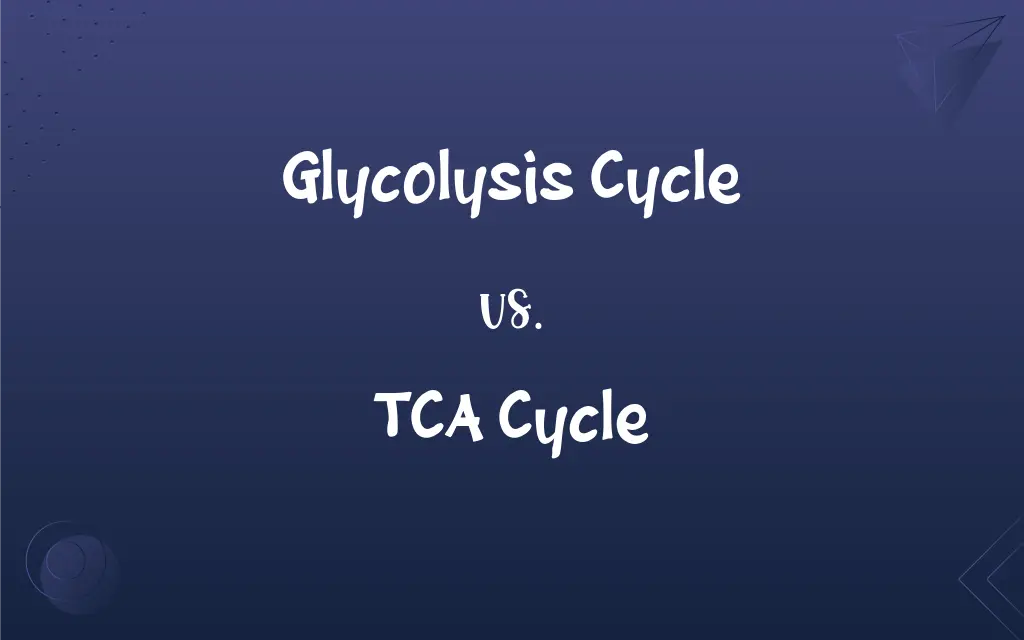Glycolysis Cycle vs. TCA Cycle: What's the Difference?
Edited by Harlon Moss || By Janet White || Published on March 9, 2024
Glycolysis is the process of breaking down glucose to pyruvate for energy, while the TCA Cycle further processes pyruvate for more energy and metabolic intermediates.

Key Differences
The Glycolysis Cycle involves the breakdown of glucose into pyruvate, yielding ATP and NADH as energy sources. The TCA Cycle (Tricarboxylic Acid Cycle), also known as the Krebs cycle, occurs in the mitochondria and further oxidizes pyruvate from glycolysis to CO2, producing additional ATP, NADH, and FADH2.
Glycolysis occurs in the cytoplasm of cells and does not require oxygen (anaerobic). In contrast, the TCA Cycle requires oxygen (aerobic) and is part of cellular respiration, occurring after glycolysis.
During Glycolysis, two ATP molecules are produced per glucose molecule, making it a less efficient energy-producing process than the TCA Cycle, which produces a larger amount of ATP through oxidative phosphorylation.
Glycolysis is the first step in the breakdown of glucose and can occur with or without the presence of oxygen. The TCA Cycle, on the other hand, is a part of aerobic respiration and does not occur in the absence of oxygen.
The Glycolysis Cycle is a universal pathway present in nearly all types of cells. In contrast, the TCA Cycle is primarily active in aerobic organisms and in oxygen-rich conditions.
ADVERTISEMENT
Comparison Chart
Location in Cell
Cytoplasm
Mitochondria
Oxygen Requirement
Anaerobic (Does not require oxygen)
Aerobic (Requires oxygen)
Energy Production
2 ATP per glucose molecule
Higher ATP yield (through oxidative phosphorylation)
Role in Metabolism
First step in glucose breakdown
Further oxidizes pyruvate from glycolysis
Dependence on Oxygen
Can occur with or without oxygen
Requires oxygen, does not occur anaerobically
ADVERTISEMENT
Glycolysis Cycle and TCA Cycle Definitions
Glycolysis Cycle
Glycolysis Cycle produces ATP and NADH without using oxygen.
Muscle cells rely on the Glycolysis Cycle during intense exercise.
TCA Cycle
TCA Cycle is essential for aerobic respiration.
The TCA Cycle ceases to function in the absence of oxygen.
Glycolysis Cycle
Glycolysis Cycle consists of a series of enzymatic reactions.
Each step in the Glycolysis Cycle is catalyzed by a specific enzyme.
TCA Cycle
TCA Cycle occurs in the mitochondria of eukaryotic cells.
Mitochondria are often referred to as the powerhouse of the cell due to the TCA Cycle.
Glycolysis Cycle
Glycolysis Cycle is the process of breaking down glucose into pyruvate.
Glycolysis Cycle is crucial for energy production in cells.
TCA Cycle
TCA Cycle generates NADH and FADH2 for ATP production.
ATP synthesis in the TCA Cycle is crucial for cell energy.
Glycolysis Cycle
Glycolysis Cycle is a universal pathway in both aerobic and anaerobic organisms.
The Glycolysis Cycle is fundamental in both human cells and yeast.
TCA Cycle
TCA Cycle is the second stage of cellular respiration.
After glycolysis, pyruvate enters the mitochondria for the TCA Cycle.
Glycolysis Cycle
Glycolysis Cycle occurs in the cytoplasm of cells.
The Glycolysis Cycle precedes the Krebs cycle in cellular respiration.
TCA Cycle
TCA Cycle is a series of chemical reactions used to release stored energy.
The TCA Cycle plays a key role in cellular respiration.
FAQs
What does the TCA Cycle primarily do?
It further oxidizes pyruvate to produce ATP, NADH, and FADH2.
Where does the TCA Cycle take place?
In the mitochondria.
Where does the Glycolysis Cycle occur in the cell?
In the cytoplasm.
Can the Glycolysis Cycle occur in anaerobic conditions?
Yes, it can occur with or without oxygen.
Is oxygen required for the Glycolysis Cycle?
No, it is anaerobic.
What is the ATP yield of the TCA Cycle?
It produces a significant amount of ATP through oxidative phosphorylation.
What is the main purpose of the Glycolysis Cycle?
To convert glucose into pyruvate, producing ATP and NADH.
How much ATP is produced in the Glycolysis Cycle?
Two ATP molecules per glucose molecule.
Are both cycles part of cellular respiration?
Yes, both are stages in cellular respiration.
What follows the Glycolysis Cycle in aerobic respiration?
The pyruvate enters the TCA Cycle.
Do all organisms have a TCA Cycle?
Only aerobic organisms have a functional TCA Cycle.
Is the Glycolysis Cycle energy-efficient?
It's less efficient in ATP production compared to the TCA Cycle.
How does the TCA Cycle contribute to overall metabolism?
It plays a central role in energy production and metabolic intermediates.
Is the Glycolysis Cycle present in all living cells?
Yes, it's a universal pathway.
Can the Glycolysis Cycle function in muscle cells during intense exercise?
Yes, it can function anaerobically in muscles.
Is the TCA Cycle an aerobic process?
Yes, it requires oxygen.
What happens to the TCA Cycle in the absence of oxygen?
It does not occur without oxygen.
What are the end products of the Glycolysis Cycle?
Pyruvate, ATP, and NADH.
What are the key products of the TCA Cycle?
ATP, NADH, FADH2, and CO2.
How does the TCA Cycle affect cellular energy levels?
It significantly boosts energy levels through high ATP production.
About Author
Written by
Janet WhiteJanet White has been an esteemed writer and blogger for Difference Wiki. Holding a Master's degree in Science and Medical Journalism from the prestigious Boston University, she has consistently demonstrated her expertise and passion for her field. When she's not immersed in her work, Janet relishes her time exercising, delving into a good book, and cherishing moments with friends and family.
Edited by
Harlon MossHarlon is a seasoned quality moderator and accomplished content writer for Difference Wiki. An alumnus of the prestigious University of California, he earned his degree in Computer Science. Leveraging his academic background, Harlon brings a meticulous and informed perspective to his work, ensuring content accuracy and excellence.
































































